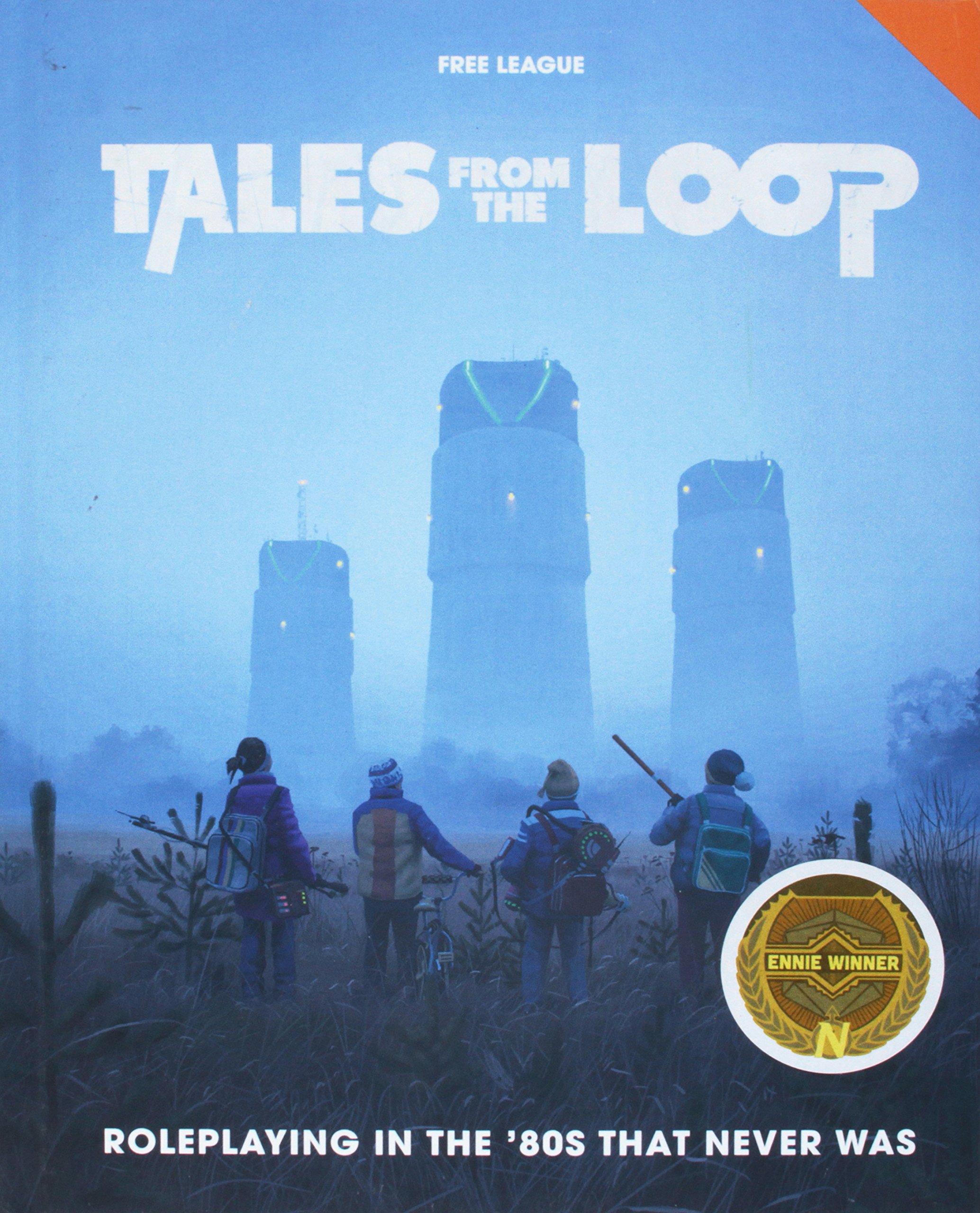Hey Know Direction fans. It’s me, Alex Augunas the Everyman Gamer, and I’m back today with another installment of my 5 Likes & 5 Dislikes series. Now, I think I might have a decent idea of what you’re thinking. You’re wondering what on earth I’m going to be talking about, right? After all, I’ve done Pathfinder 1E, Pathfinder 2E, and Starfinder. What more could I possibly do with Paizo games? The Adventure Card Game? Nah. Card games aren’t really my thing anymore. I’ve been clean of cardboard crack for, like, almost a decade now!
So, if not the Adventure Card Game, what? Well, my friends, I’m switching up the formula. I’m not talking about a Paizo game today. Instead, I’ll be talking about my new love, Tales from the Loop. You might have hard of it; the game is getting an Amazon adaptation in a few months that looks pretty sweet. Well, what are we waiting for? Let’s dive into it!
 What The Heck Is This?!
What The Heck Is This?!
Oh, right. You might not know what this game is, right? Okay, so to briefly summarize this game, its a TTRPG that takes place in an alternate future version of earth where humanity developed robots and particle accelerators in the 80s, as well as other “strange science” contraptions. You play a kid living in this world that’s otherwise identical to the real-world 1980s, specifically a whippersnapper living either in Boulder City, Nevada in the United States or the Mälaröarna islands outside of Stockholm in Sweeden. You solve mysteries that the adults in your life are either too stupid or too incompetent to solve themselves. And that’s basically the game. It’s very much inspired by things like Stranger Things. If you want to learn more about the game (perhaps buy it for yourself), check out this link.
Okay, NOW let’s get started!
Like 1 — The Mechanics are Simple
This might sound like a weird thing for me, Mr. Game Mechanics, to like, but Tales from the Loop has a delightfully simple game mechanic system. I’m going to try and explain it quickly and without a whole lot of detail.
- Whenever you’re in Trouble (ie something happens that you need dice to determine the outcome), the GM tells you how difficult the Trouble is by telling you how many successes you’ll need to overcome it. This is typically a number between 1 and 3, but the game doesn’t actually say you can’t require more successes if you want. The GM either tells you what skill you can use to overcome the Trouble, or sometimes the GM will allow the Kid to pick what skill they’re going to try and use instead; skill use informs the number of successes needed, so if you try to use a skill in a way that’s unlikely to work, the GM can bump up the number of successes you need.
- The Kid who’s testing for the trouble picks up a bunch of d6s. The number is equal to the number of points they have in the skill (1 to 5) plus their attribute (also 1 to 5). The kid might get to add additional dice if they’re using an appropriate item or getting some other benefit. They then roll all of those d6s.
- The Kid counts the number of “sixes” they roll out of all their dice. Every six is a success.
- If the Kid gets enough successes, they succeed. If they get more than enough successes, every skill has a list of “bonus effects” that the kid can choose to impose upon the situation. The GM and the Kid can work together to make up custom effects if appropriate. If the Kid doesn’t get enough successes; something bad happens. This is often a Condition, which represents things like being Upset or Scared.
And that’s basically it for the game’s mechanics. There are other rules, of course, but that’s how you play the game. And it’s so delightfully simple! Very easy to touch to just about anyone. I really enjoy a complex game like Starfinder or Dungeons and Dragons, but I found Tales from the Loop’s simplicity refreshing.
Dislike 1 — Items are Kind of Boring
I mentioned earlier that there are other rules in Tales from the Loop, and one of the rules I’m not a big fan of is the item mechanic. Basically, if you have an item that’s particularly relevant in a situation, having that item gives you a bonus to the number of dice you get to roll when you’re in Trouble … and that’s about it. I would have liked more in-depth item rules. For example, a mechanic of “vices” that can temporarily relieve conditions for at a cost (obviously not actual vices since this is a kid’s game, but you get what I mean). A great example is chewing gum. Maybe my character REALLY likes to chew gum, so if I’m Upset I can chew gum once a mystery to get rid of the condition. This is an easy enough house rule, but I feel like items were wasted potential in this game because they could have really added to the roleplaying and flavor each character brings to the table, but the writers didn’t go that extra mile.
Like 2 — The Balance of Age
Anyone who follows my imprint, Everybody Games, knows that I love me some good rules for playing young characters. Since Tales from the Loop is all about playing Kids, you’d hope this game handles playing young characters well, right? Well friends, I’m pleased to tell you that this game has a lovely mechanic for balancing playing young kids against teenagers. Before I get into it, however, you need to understand that Tales from the Loop has a hero point system called Luck Points, where you can spend a point to reroll your Trouble dice (yes, all of them). Now, your number of Luck Points is limited; they only reference after each mystery (the equivalent of an Organized Play scenario), so you have to relish them. With this in mind, the number of Luck Points you get is equal to 15 minus your age. In Tales from the Loop, you can be between 10 years old and 15 years old, so this means that you have 5 Luck Points if you’re the minimum age (10 years old) and 0 Luck Points if you’re the maximum possible age (15 years old).
Okay, so clearly Luck favors the young in this game. So what do you get for being old? Well, I mentioned early that the game has attributes, right? There are four in all: Body, Tech, Heart, and Mind. You start with a number of points in your attributes equal to your age, and can have up to 5 points in each. Also, you need to have at least 1 point in each attribute. This means that a 10 year old effectively has 6 points they can flex wherever they want while a 15 year old has 11 points.
This means that if you’re older, you have a better chance to succeed with every roll you make, but if you’re younger you have more opportunities to recover from failure. And since the average Trouble only needs one succeed, it really is a toss-up regarding which option is better. In earnest, its probably best to balance between the two; play someone who’s 12 or 13 so you have a few Luck Points and a few extra attribute points. Its such an interesting mental puzzle that I adore this rule set for its depth and simplicity.
Dislike 2 — Adventures Aren’t Very Detailed
As you might expect from a game whose rules can be summarized in a paragraph, Tales from the Loop uses most of its page count to explore its setting and offer some sample adventures. In fact, most of the published books I’ve seen from Tales from the Loop are potential adventures. I wouldn’t call them campaign settings, because the only places in the book to set your games are the two loop locations I mentioned earlier; it’s still like, “A factory releases a new toy based on a popular comic book. The toys are miniature robots and are alive.” And this is pretty cool, to be honest. But I am SO spoiled by Paizo giving me a detailed list of what happens, where, and why that to me, Tales from the Loop’s prewritten adventures seem more like outlines to me rather than a fully prewritten adventure. Don’t get me wrong, the adventures do a TON of work for you and they were great for me as I worked to plan my own Tales from the Loop setting and adventure, but overall none of the adventure outlines I read really grabbed me as something I wanted to run. But that might not be the case for you; this list is very subjective.
Like 3 — Character Building Is the Breakfast Club
Tales from the Loop has “classes” in a way that’s amazing and fun. Instead of “fighter” or “mage” or “cleric”, however, Tales from the Loop uses the archetypal teenager cliques as its classes. Bookworm, Jock, Popular Kid, Troublemaker, Weirdo, these are the classes you get to play. The classes themselves are pretty basic; each “archetype” has a a few key skills (which means you can start with a higher-than-1 value in that skill) and that’s basically it. I wasn’t lying when I said that this was a VERY simple game and that I love it for it.
Dislike 3 — It Uses the “Adults Are Useless” Trope
Many different media outlets that use young characters often fall into a trope called “Adults are Useless.” You can read about it here, but the gist of the concept is that Tales from the Loop assumes that aside from getting comforted by a parent or older sibling, adults can’t do anything for the Kids playing the game. The policemen will fail to do what’s needed, or if the kids go to someone for help there’s a negative consequence for doing so. The example given is something like, “You can ask your older brother for help, but he’ll make you give him your allowance for a month.” I don’t really care for this trope, personally. One of the most refreshing things about Stranger Things to me was the fact that it was multigenerational, and that the kids were always doing something interesting. Sure, when the kids and the adults got back together, the adults always try to engineer the situation so the kids are as safe as possible and that goes horribly wrong every time. But ultimately, Stranger Things never had the adult characters act in ways one would consider useless; there’s a strong sense of family between the characters, both biological and found. While it might be genre appropriate that Tales from the Loop sort of just tosses this out of the window in favor of “Adults are Useless,” I personally dislike this element of the game strongly and will be ignoring it whenever I run games with the system.
Like 4 — The Art is Incredible
I love the art for Tales from the Loop; all of the art is drawn in the same style. Simon Stålenhag, a Sweedish artist, is the person to thank for this. Rather than talk about it, here’s some links to his art. Go check it out.
Dislike 4 — The Setting Doesn’t Feel Very Occult
I mentioned before that I was going to make my own Tales from the Loop setting rather than use the one in the book. Why? Well, one of the things that I’m not all too crazy about in this book is its focus on the ordinary and the mundane. There are fantastic robots and weird technologies in Tales from the Loop, but those things are described as being relatively ordinary to the kids. I mean, all kids are going to experience things that are new and fantastic to them simply because they’re young, but the fact that the setting has these wondrous automated robots and we’re told to just treat them as being normal … nah. I’m not really a fan of that.
Like 5 — There’s a Sequel / Expansion!
I haven’t bought the book yet, but there’s apparently a second book called Things from the Flood that’s a continuation of Tales from the Loop. It serves as a stand alone game using the same mechanics as Tales from the Loop, with the major different being that you play teenagers instead of kids, and you can very much die in the game. Things from the Flood takes place in the 90s, and features weird technological “things” coming out and causing bad times for everyone. In my opinion, that’s a pretty brilliant way to expand your game; create it in a way where the new game feels like a natural expansion and continuation of the original one. It’s definitely a book that I want to pick up and own myself!
Dislike 5 — This Book is SUPER White
… yeah. I have to talk about this. There’s ONE picture of someone who isn’t a white kid in this book; it’s the archetypical book worm character, and it’s for a piece of art that isn’t in color. Every other picture of a person in this book is of a Caucasian person, kid or adult. This kind of felt out of place to me since this book was published in 2017, and black people ABSOLUTELY existed in the 80s. The art in the book does overwhelming feature Sweedish locations over American ones, sure, and Sweden isn’t known for its black populations, sure, but ROBOTS are ordinary in this world. Surely if robots are going to be commonplace in this world, they could take a few additional liberties and add some black people to their 1980s game too.
In Conclusion,
I’ve had my eye on Tales from the Loop since it won an ENnie a few years ago, and I finally got around to picking it up this year. I regret not buying this sooner. It’s a great game that manages to have a lot of mechanical depth despite its relatively rules-lite system, and I’m super excited with how expandable the game appears. I have some neat stuff that I want to do with Tales from the Loop in the near future, and I’m so pleased that this is a game that I feel I can use to tell the story I want to tell!
Thanks for sticking it out with me as I discuss a game you might not have heard of before. What did you think? Did you like me departing from Paizo Land, or do you want me to stay there a bit more? If you have Tales from the Loop, what did you think? I’d love to hear from you at the Know Direction Discord when you get the chance!

Alexander “Alex” Augunas, the Everyman Gamer, has been playing Tabletop Roleplaying Games since 2007 after a friend pretended to be his father in order to smuggle him out of high school so his gaming group had enough people to run a module. Today, Alex is the owner and publisher of Everybody Games, a co-host on Know Direction: Beyond and RPG Design Club, and a player on Stellar. You can follow Alex’s exploits on Twitter (@AlJAug), on Facebook, or on Patreon. Know Direction fans are also welcome to “@Alex” him on the Know Direction discord server!






